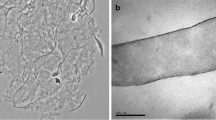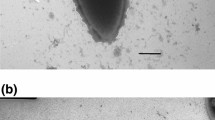Abstract
Hydrogen-oxidizing acetogenic bacteria in pure culture are presently represented by the two mesophilic species, Acetobacterium woodii and Clostridium aceticum. From Lake Kivu we have isolated a Gram negative, chemolithotrophic, thermophilic anaerobe (LKT-1) that oxidizes hydrogen and reduces carbon dioxide to acetic acid. It is a non-motile, non-sporeforming rod, about 0.7μm in width and 2–7.5μm in length, often occuring in pairs or chains. The cell wall has a banded appearance; the surface layer contains a regular array of particles with six-fold rotational symmetry. No outer membrane is present. The temperature optimum for growth is 66°C, and the pH optimum is 6.4. Organic growth substrates include glucose, mannose, fructose, pyruvate, and formate; acetate is the principal product. The doubling time for growth on hydrogen and carbon dioxide is about 2h. Vitamins are neither required nor stimulatory. Yeast extract and Trypticase enhance the final yield but do not affect the growth rate. Cysteine or sulfide are required and cannot be replaced by thioglycolate or dithiothreitol. LKT-1 was mass cultured on hydrogen and carbon dioxide in a 24.1 fermentor with a yield of 34g (wet weight) of cells. The DNA base composition as determined by buoyant density is 38 mol % guanine plus cytosine. LKT-1 appears only distantly related to physiologically similar bacteria. A new genus Acetogenium is proposed, and the species is Acetogenium kivui.
Similar content being viewed by others
References
Andreesen JR, Gottschalk G, Schlegel HG (1970) Clostridium formicoaceticum nov. spec. Isolation, description, and distinction from C. aceticum and C. thermoaceticum. Arch Mikrobiol 72:154–174
Balch WE, Fox GE, Magrum LJ, Woese CR, Wolfe RS (1979) Methanogens: reevaluation of a unique biological group. Microbiol Revs 43:260–296
Balch WE, Schoberth S, Tanner RS, Wolfe RS (1972) Acetobacterium, a new genus of hydrogen-oxidizing, carbon dioxide-reducing, anaerobic bacteria. Int J Syst Bacteriol 27:355–361
Balch WE, Wolfe RS (1976) New approach to the cultivation of methanogenic bacteria: 2-mercaptoethanesulfonic acid (HS-CoM)-dependent growth of Methanobacterium ruminantium in a pressurized atmosphere. Appl Environ Microbiol 32:781–791
Braun M, Mayer F, Gottschalk G (1981) Clostridium aceticum (Weiringa), a microorganism producing acetic acid from molecular hydrogen and carbon dioxide. Arch Microbiol 128:288–293
Braun M, Schoberth S, Gottschalk G (1979) Enumeration of bacteria forming acetate from H2 and CO2 in anaerobic habitats. Arch Microbiol 120:201–204
Fischer F, Lieske R, Winzer K (1932) Biologische Gasreaktionen. II. Mitteilung: über die Bildung von Essigsäure bei der biologischen Umsetzung von Kohlenoxyd und Kohlensäure mit Wasserstoff zu Methan. Biochem Z 245:2–12
Fontaine FE, Peterson WH, McCoy E, Johnson MJ, Ritter GJ (1942) A new type of glucose fermentation by Clostridium thermoaceticum n. sp J Bacteriol 43:701–715
Glauert AM, Thornley MF (1969) The topography of the bacterial cell wall. Ann Rev Microbiol 23:159–198
Karlsson JL, Volcani BE, Barker HA (1948) The nutritional requirements of Clostridium aceticum. J Bacteriol 56:781–782
Marmur J (1961) A procedure for the isolation of deoxyribonucleic acid from microorganisms. J Mol Biol 3:208–218
Mayer F, Lurz R, Schoberth S (1977) Electron microscopic investigation of the hydrogen-oxidizing acetate-forming auaerobic bacterium Acetobacterium woodii. Arch Microbiol 115:207–213
Ohwaki K, Hungate RE (1977) Hydrogen utilization by clostridia in sewage sludge. Appl Environ Microbiol 33:1270–1274
Olson JA (1959) Spectrophotometric measurement of α-keto acid semicarbazones. Arch Biochem Biophys 85:225–233
Rose JA, Grunberg-Manogo M, Korey SR, Ochoa S (1954) Enzymatic phosphorylation of acetate. J Biol Chem 211:737–756
Salanitro J, Muirhead PA (1975) Quantitative method for the gas chromatographic analysis of short-chain monocarboxylic and dicarboxylic acids in fermentation media. Appl Microbiol 29:374–381
Schildkraut CL, Marmur J, Doty P (1962) Determination of the base composition of deoxyribonucleic acid from its buoyant density in CsCl. J Mol Biol 4:430–443
Tanner RS, Wolfe RS, Ljungdahl LG (1978) Tetrahydrofolate enzyme levels in Acetobacterium woodii and their implication in the synthesis of acetate from CO2. J Bacteriol 134:668–670
Weiringa KT (1936) Over het verdwijnen van waterstof en koolzuur onder anaerobe voorwaarden. Antonie van Leeuwenhoek J Microbiol Serol 3:263–273
Weiringa KT (1940) The formation of acetic acid from carbon dioxide and hydrogen by anaerobic spore-forming bacteria. Antonie van Leeuwenhoek. J Microbiol Serol 6:251–262
Wolin EA, Wolin MJ, Wolfe RS (1963) Formation of methane by bacterial extracts. J Biol Chem 238:2882–2886
Author information
Authors and Affiliations
Rights and permissions
About this article
Cite this article
Leigh, J.A., Mayer, F. & Wolfe, R.S. Acetogenium kivui, a new thermophilic hydrogen-oxidizing acetogenic bacterium. Arch. Microbiol. 129, 275–280 (1981). https://doi.org/10.1007/BF00414697
Received:
Accepted:
Issue Date:
DOI: https://doi.org/10.1007/BF00414697




